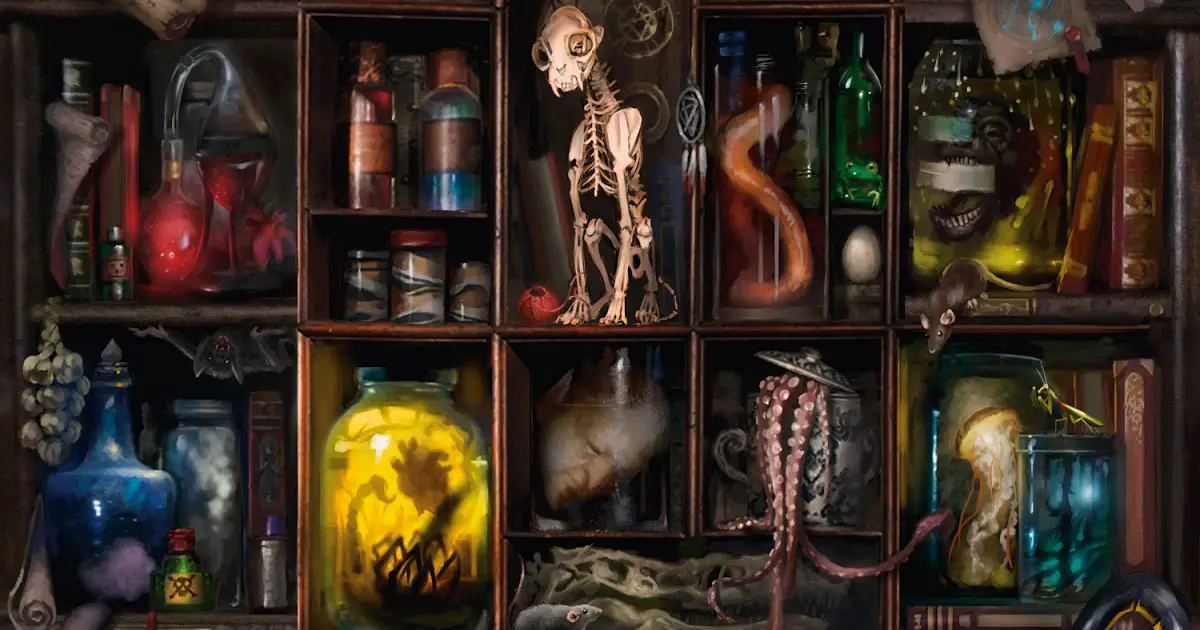A common question asked by those who are new to D&D 5e is “how does attunement work?”
In some of the older editions of the game, it was possible to build up your own arsenal of magical items to carry around everywhere. While that might sound cool, it was honestly more of a hassle than anything! Character sheets would very quickly turn into character packets!
In keeping with 5e’s streamlined design, the attunement mechanic means that you have to be pickier about which magic items you carry. However, it also results in magic items being far more powerful!
So today we’re talking about attunement in D&D 5e and how it works!
What is Attunement in D&D 5e?
Think of attunement as “unlocking” the magical abilities of certain magic items. These items require your character to form a bond with them (i.e. attuning to them) to work.
Some items may have certain prerequisites or requirements to be attuned with. For example, anyone can attune to the Boots of Elvenkind, but a Pearl of Power requires attunement by a spellcaster. To qualify as a spellcaster, the character must be able to cast at least one spell using their traits or features.
Artificers of level 14 or higher and Thief Rogues of level 13 or higher get to ignore these requirements because of their specific class abilities. Everyone else has to pay close attention to an item’s requirements.
The Dungeon Master’s Guide contains a large amount of magical items and details their effects and attunement requirements. If your campaign includes magical items, you will definitely want to check out the DMG.
You may also like Tasha’s Cauldron of Everything which added 46 more magical items to the game including my personal favorite, magical tattoos! Magical tattoos have a unique and flavorful take on attunement which you can read about in our article on the Tattoos of Tasha’s Cauldron.
Once a magic item has been attuned to, the character is able to use the item’s abilities as described. We’ll go over what goes into the attunement process in just a moment.
Can a Magic Item Be Used Without Attunement?
Some magic items can be used without attuning to them.
Some items, like a Bag of Holding or Alchemy Jug, simply don’t require attunement to use. These are wondrous items that can be used by anyone.
Other items that do require attunement can be used in a manner that makes sense for the item, but the magical effects cannot be activated. For example, a Staff of Striking could still be used just as a normal quarterstaff (without the magical effects and +3 benefit to attack/damage) until it is attuned to.
While you will almost certainly want to make time to attune to these items, sometimes you may find yourself in a pinch and need to use them without their magical effects.
How to Attune to Magic Items in D&D 5e
Attuning to magic items is a relatively straightforward process that requires a character’s undivided attention.
To attune to a magic item, a character must spend a short rest (at least 1 hour) with the item. For a weapon, this might mean practicing with it. For a wondrous item, this might take the form of meditating while holding it. At the end of the short rest, the character has attuned to the item.
Being attuned to the item means that the character can use the item’s magical abilities and understands whatever triggers (like command words) the item may require.
It is worth noting that this short rest must be entirely spent interacting with the item. This means that you cannot use the short rest for anything else like spending hit dice, recovering spells, and so on. If you find that you also need to do those things, you will need to take another short rest to do so.
If you don’t have someone in your party who can cast the Identify spell, you can opt to take a short rest to figure out what the magic item does without attuning to it. This cannot be the same short rest that you use to attune to the item.
Losing Attunement to an Item
Some situations may cause a character to lose their attunement to a particular item.
Firstly, a character drops their attunement with a magical item if they no longer satisfy the item’s prerequisites.
For example, an item may require attunement by a “good” creature. If the Lawful Good Paladin has just knowingly committed some act or acts that would justify their alignment being changed to “Neutral” or “Evil,” they would lose attunement to the item.
Secondly, attunement is lost if the item is more than 100 feet away from the character for more than 24 hours. Additionally, another character attuning to the item causes the attunement to drop.
Finally, a character can voluntarily choose to end their attunement with a magical item. To do this, they can spend another short rest focusing on the item. This works on any magical item that is not cursed. Those work a bit differently, but we’ll save that for another article.
Attunement Limits
With one exception, a character can only attune to 3 magical items at a given time. These items cannot be duplicates (such as more than one Ring of Protection). Additionally, as mentioned above, an item can only be attuned to one character at a time.
Attempting to attune to a fourth item fails. A character must spend time dropping their attunement to one of their already-attuned items before attuning to the new one.
Attuning to More Than Three Items
One of the perks that Artificers enjoy is the ability to attune to more magic items than other classes.
They gain extra attunement slots upon hitting levels 10, 14, and 18 and can ultimately attune to a whopping six magical items at a time. Because Artificers love their shiny toys, they are the only exception to the attunement limits in D&D 5e.
Conclusion – Attunement in D&D 5e
All in all, attunement in D&D 5e is a very useful mechanic. There are plenty of magical items that don’t require attunement that are fun to use, but most of the items that require attuning to are well worth it.
Because magical items can quickly change the game’s balance, having the attunement rules does a lot to keep the game moving forward in a fun and consistent way.
Though more magical items does mean that fights will need to get harder to compensate! For DMs out there who want to start planning some epic combats to challenge their players, I recommend checking out my review of the best book for D&D monster tactics by far!
Still got questions about attuning to magic items in D&D 5e? Just want to say hi?
Hit me up in the comments!









